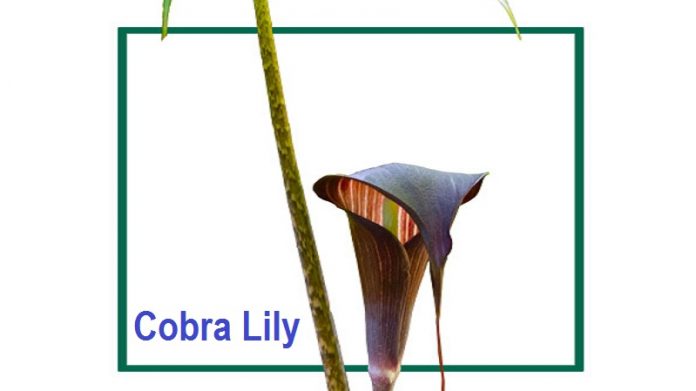Arisaema speciosum (Cobra-Lily)
The word Arisaema (बाको) is derived from two Greek words ‘aris’ and ‘haima’ in reference to the red spotted leaves of some species. It is commonly known by the name Jack-in-the-pulpit and Cobra Lily. Arisaema speciosum is a bulbous perennial native to the greater Himalayan region from Nepal, through Sikkim, Arunachal Pradesh and the northern part of West Bengal in India, to Bhutan, Southern Tibet, Northern Myanmar and the Gaoligongshan area of Yunnan, China. There are approximately 150 species of Arisaema in the world. Arisaema speciosum has medium-sized chocolate-maroon coloured spathes with white stripes arranged in a vertical fan-shape. The tip of the spathe hood is elongated and often droops down and together with the long attenuated spadix appendage gives this Arisaema one of its common names, the Double Whip Cobra Lily. Spathe is up to 20 cm long, dark black-purple and longitudinally striped towards the base with white, with a broadly lanceshaped curved blade narrowed to the tip. Spadix appendage is dark purple, thickened curved and white at the base, and with very long thread-like tail 20-80 cm. The plant can also be distinguished by its distinctly stalked unequal elliptic leaflets up to a foot long, with red margins, and its mottled dark purple leaf-stalk up to 40 cm, or more.
Propagation of Arisaema
- Vegetative: Some species produce offsets readily, which can be detached from the parent. In some (e.g. A. candidissimum) the small tubers are found already detached. Other species are moderately stoloniferous (e.g. A. ciliatum, A. exappendiculatum).
- Seed: Most species are dioecious (unisex) and only the female produces seed. Therefore, usually a male and female plant are needed to make fertile seed. This is further complicated by the fact that the plants can, and do, change sex. Young plants are invariably male and become female as they get older and more robust, sometimes going through a monoecious (bisexual) stage in the transition. A few species (e.g. flavum, tortuosum) remain monoecious, although not usually self- fertile.
Climatic requirements of Arisaema
It grows in warm temperate monsoon forest at elevations up to 3500m. The optimal day temperature for its growth is 20-25°C and night temperature is 15-20°C. While many species in the wild may grow in full or partial sun at high altitudes, in most gardening situations arisaemas should be considered plants for at least partial shade. Bright light without leaf burning is ideal.
Soil requirement of Arisaema
Generally neutral or slightly acid pH seems to work well. Drainage very important to prevent rotting of tubers. Raised beds, added gravel, turface (calcined clay) or other soil aerators are suitable for its growth.
Diseases and Pests of Arisaema
Not eaten by most animals because of high oxalate content in tubers.Biggest threat is probably “Rust”, a fungal disease manifested by yellowish-orange spots on the leaves and spathe, and very difficult to control once it appears.
Procedures for pot culture of Arisaema
-
Seed Preparation
- If fresh seed heads or berries are available, remove the seeds from the pulp (wear latex gloves while doing this, or your fingers will burn for days) and rinse in several changes of water until the seeds are clean.
- They are then ready for sowing. It is helpful to soak dry seeds for approximately 48 hours with several changes of water during that time before sowing.
- Anecdotal evidence suggests that soaked seeds germinate 2 to 4 weeks ahead of unsoaked seeds.
2. Germination mix
- The mix must be free draining; soggy conditions promote rot.
- Use three parts Fafard Super- Fine Germinating Mix to one-part granite chick (starter) grit.
- The Fafard mix contains peat moss, vermiculite, perlite, and a starter charge of fertilizer.
3. Pots
- Use nine cm pots for everything because they fit neatly, 18 to a 25 cm by 51 cm tray.
- Sow a lot of seeds, a deeper and narrower pot might be preferred.
- The nine cm pot works well as long as the mix drains freely; a deeper pot would simply promote even freer drainage.
4. Sowing
- Fill the pots and water the mix to settle it (the surface of the mix should be approximately two cm below the top of the pot).
- After the pots drain, the seeds are sowed on the surface of the mix and sprayed lightly with water to ensure proper contact with the mix.
- The surface is then covered with approximately one cm of chick (starter) grit.
- If starting large numbers of pots at the same time, saturate the pot surfaces with a Captan spray to prevent damping-off.
- Sow 25 to 50 seeds in a nine cm pot, but that would be too many if the corms were going to be grown on in the same pot for another year.
- Prefer to crowd them at first and separate them later (during their first dormancy).
5. Growing On
- The pots are then placed under lights, and more or less left alone, except that surface moisture should be checked every few days and replenished as necessary.
- It is very important that germinating seeds never dry out.
- Prefer surface watering, on the theory that it is less likely to saturate the bottom of the pot and create future problems.
- Once leaves emerge, fertilize from time to time.
- Try to keep the medium evenly moist as the leaves develop; once they are completely unfurled, they will tolerate slight drying, but excessive drying may send them into a premature dormancy.
- Once the leaves are fully unfurled on all of the seedlings remove the pots from the warm polytents and set them under uncovered lights to grow on. Find the cooler temperatures promote more compact growth and, of course, reduce the likelihood of fungal infections.
- At this point, the objective is simply to keep the leaf active and photosynthesizing for as long as possible, in order to build up as large a corm as possible before dormancy sets in.
Health benefits of Arisaema
- The raw herb is used for its irritant effect, being applied topically for skin diseases with infection and swelling (e.g., abscesses); it damages the bacteria and stimulates a healing response.
- Corm is used for vomiting and gastric fullness.
- It is especially used for eliminating wind and relieving convulsions, thus used to treat stroke, vertigo, and tetanus.
- In modern practice, arisaema is included in formulas for post-stroke syndrome when there is evident phlegm accumulation and for cases of Alzheimer’s disease; other applications include advanced (severe) arthritis, carpal-tunnel syndrome (especially in persons who are overweight), headaches (when phlegm obstruction is deemed one of the contributing factors), and bronchitis with sputum production.

